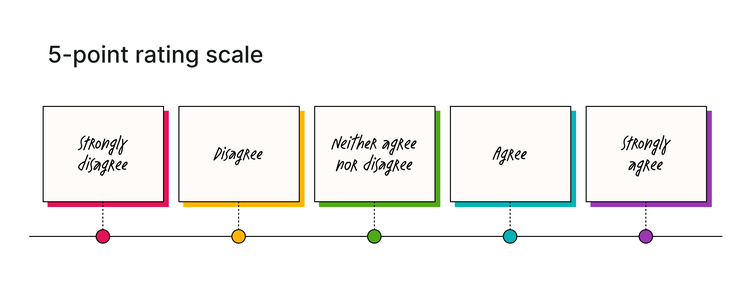
Employee surveys are an HR practitioner’s greatest tool when it comes to gathering employee feedback at scale. Survey results can help you uncover important trends in employee sentiment across your organization that may not otherwise surface in anecdotal feedback. There are many different types of employee surveys – including engagement; development; diversity, equity, and inclusion; onboarding; and exit – which can help inform people decisions to improve the employee experience.
In this guide, we take a deeper dive into the following types of employee surveys:
- Employee engagement
- Employee satisfaction
- Employee pulse
- Team effectiveness
- Candidate
- Onboarding
- 90-day probation period
- Exit
- Diversity, equity, and inclusion (DEI)
- Employee wellbeing
- Accountability
- Change
- Benefits
- Sustainability
Why employee surveys are important
Beyond giving HR teams visibility into employee sentiment, employee surveys help leaders make better decisions by providing key insights into engagement, retention, employee performance, DEI, and more. Moreover, they help leaders identify what is and isn’t working, prove the value of HR initiatives, and track progress over time. Employee surveys support internal decision-making while also empowering you to benchmark results against peer industries and track your progress over time.
Employee surveys are valuable for employees, too. Benefits of conducting regular surveys include:
- Giving employees a platform to share their feedback
- Encouraging employees to reflect on their own experiences
- Helping employees change their behaviors while seeing themselves as “in control” and “changemakers”
- Inviting employees to have a stake in the survey outcomes
By giving employees a chance to share their input, you’re letting them know that their thoughts, opinions, and experiences are valued. In that way, conducting surveys help organizations better engage, motivate, and retain their workforce.
How to conduct an employee survey
1. Decide on your goals
Before you start your journey, it’s critical to determine where you want to go. In this case, that means understanding what kind of information you want to get from surveying your employees. You may be looking to understand the employee response to one particular initiative or how they feel about the overall company culture. You may want to identify pain points or gaps in your onboarding process or learn why you’re seeing a spike in turnover. Clarifying what questions you want answered will help you decide what kind of survey to hold.
2. Select your survey questions
When selecting questions for your employee surveys it’s important to think about what kinds of answers will help you take action. Further, make sure your questions are clear and direct. This ensures people understand each question and makes it easier for them to answer openly and honestly, giving you better feedback to analyze and act on.
There are pros and cons to both using pre-written questions and writing your own questions. Custom survey questions may simply rephrase the question in a way that is better aligned to your company culture, or they can be completely new. Scientifically validated survey questions are a useful baseline, but every company faces a unique set of challenges that may require more company-specific questions. Ultimately, you’ll likely choose to include a combination of the two. Your employee survey tool will ideally provide a robust set of validated questions while also allowing you to write your own custom survey questions.
Deeper dive: Should employee surveys be anonymous?
Allowing people to give anonymous or confidential feedback creates an opportunity for them to say what they actually think without fear of repercussion. Administering a genuinely anonymous employee survey may help you gather honest feedback, but it will make it extremely difficult to take effective action. There are levels of anonymity in employee feedback, and the key is to find the right balance for your goals.
Instead of an entirely anonymous survey, we recommend collecting employee feedback in a way that doesn’t identify the individual, but provides certain contextual information (ie. demographic, team, tenure, etc.). With this approach, leaders and managers who view the feedback will be less likely to trace a particular piece of feedback to a single person. However, the right contextual information will let you see important trends in your analysis. For example, it may become clear that a high percentage of employees on one particular team are looking for more development opportunities. This kind of information can help you determine what to prioritize.
3. Pick a survey scale
When designing your survey, you can pick different types of survey questions, including multiple select, single select, free response, and a rating scale. Choose the question type that makes the survey experience easiest for people and also gives you the data in the format you need for analysis purposes.
If you use choose to use a rating scale, we strongly recommend using a 5-point Likert scale, with the following options: Strongly disagree, Disagree, Neither agree nor disagree, Agree, and Strongly agree.

In our experience, a 5-point scale encourages survey participation (fewer choices means it’s faster to complete), while still gathering the appropriate amount of detail.
4. Clearly communicate the survey
Clarity about the process encourages employee survey participation, which leads to actionable data to help you make better decisions. When administering surveys, it’s important to communicate:
- What you’re measuring
- What outcomes you’re trying to achieve
- The company’s desire for honest and candid feedback
- What to expect throughout the process
- Steps taken to protect confidentiality
- How results will be shared
Beyond these basics, creatively branding and promoting your survey is an easy way to improve participation. There are three important touchpoints in the survey process to consider in your communications: pre-survey, launch day, and post-survey.
When trying to encourage survey participation, do:
- Emphasize confidentiality and data security in the survey process
- Outline how feedback will be reviewed and the approach for taking action
- Role model the behavior you're seeking
On the flipside, don’t ask people directly if they've taken the survey yet, as they may feel coerced into answering. Not participating itself is a metric of engagement, and pushing employees to participate may bias results, as these employees might simply “click through” the survey instead of answering authentically.
Check out this article for a deep dive into the elements of a successful survey communication framework.
5. Interpret and take action on the survey results
After conducting your survey, you need to understand what the data is saying in order to take effective action on the feedback. Jump below to learn how to read and take action on survey results.
14 types of employee surveys and example questions
Employee surveys cover a wide range of topics and vary in length and cadence. The possibilities are endless, so when you’re first starting out, it can be helpful to utilize existing survey templates. In this section, we’ll provide a brief overview of some of the most common and impactful survey types and provide examples of employee survey questions one would expect to see.
Employee engagement
Employee engagement represents the levels of enthusiasm and connection employees have with their organization. It's a measure of how motivated people are to put in extra effort for their organization, and a sign of how committed they are to staying there.
Engaged employees lead to higher-performing, more resilient organizations, and employee engagement surveys are key to understanding what your employees care about the most. Engagement surveys can help you identify where employees want to see the most improvement, which enables you to strategically invest resources and time into the areas that will deliver true impact across your organization.
Employee engagement survey question examples:
Although there are many types of questions that can be asked in an employee engagement survey, there are five “key” questions that make up what Culture Amp refers to as the “Engagement index:”
- I am proud to work for [Company]
- I would recommend [Company] as a great place to work
- I rarely think about looking for a job at another company
- I see myself still working at [Company] in two years’ time
- [Company] motivates me to go beyond what I would in a similar role elsewhere
Get 20 employee engagement survey questions to use in your next survey.
Employee satisfaction
Although employee engagement and employee satisfaction may sound very similar, they measure two distinct things. While employee engagement surveys measure how motivated, committed, and proud an employee feels about their company, employee satisfaction surveys measure whether an employee enjoys (i.e., is satisfied with) their job and workplace, relative to their expectations. When conducting an employee satisfaction survey, you may want to focus in on any specific areas of concern.
Employee satisfaction survey question examples:
- Do you clearly understand the company’s strategic objectives?
- [Strongly disagree / Disagree / Neither agree nor disagree / Agree / Strongly agree]
- Do you enjoy our company’s culture?
- [Strongly disagree / Disagree / Neither agree nor disagree / Agree / Strongly agree]
- Do you think work is fairly distributed across teams?
- [Strongly disagree / Disagree / Neither agree nor disagree / Agree / Strongly agree]
- Are you satisfied by your job overall?
- [Strongly disagree / Disagree / Neither agree nor disagree / Agree / Strongly agree]
Deeper dive: Why we recommend employee engagement surveys over employee satisfaction surveys
While leaders should certainly care about whether employees are satisfied with their jobs, Culture Amp believes that employee engagement is a much more relevant and telling metric for the business. This is because engaged employees are satisfied – but not all satisfied employees are engaged in their job. While satisfied employees may be content with their jobs and dutifully fulfill their responsibilities, they will never go above and beyond for the sake of their team or larger organization.
Knowing that an employee is satisfied with their job doesn’t actually tell you how motivated they are by your company’s vision, how committed they are to helping the organization work through difficult times, or how positively they feel about their future at your company. This is why we strongly recommend running employee engagement surveys over employee satisfaction surveys.
Employee pulse
It may not be feasible to run an in-depth survey regularly, but keeping tabs on how employee engagement levels ebb and flow is key to making the right decisions. An employee pulse survey is a quick check-in, run weekly or monthly, that provides a snapshot of employee engagement in a given moment. These surveys serve as a strategic complement to your main employee engagement survey and can be used to track progress on the rollout of new engagement initiatives.
Pulse surveys are generally shorter, though they often include some of the same core questions used in your main engagement survey. They sometimes also incorporate questions focused on a specific, prioritized area of the organization (i.e., leadership, employee development, etc.). Another set of questions to consider are those focusing on actions taken by the company in response to previous surveys.
Recommended yearly survey structure:
Q1: Baseline engagement survey
- This serves as your baseline for the year. A baseline engagement survey typically includes around 50 questions.
Q2: Pulse survey
- This survey is a quick status check on your results from Q1. Your first pulse survey should include around 10-15 questions. It will help you understand if you’re moving the needle on any previously identified issues.
Q3: Deep dive survey
- A deep dive survey can be tailored to focus on a particular issue that’s too difficult to unpack in an engagement survey, like company values, employee wellbeing, manager effectiveness, or inclusion.
Q4: Pulse survey
- The final pulse survey of the year acts as a follow-up on a specific area for your business, while still touching on core engagement questions.
Employee pulse survey question examples:
- I have been provided an opportunity to see and discuss our recent employee survey results
- [Strongly disagree / Disagree / Neither agree nor disagree / Agree / Strongly agree]
- My manager, or someone else, has communicated some clear actions based on recent employee survey results
- [Strongly disagree / Disagree / Neither agree nor disagree / Agree / Strongly agree]
- I have seen positive changes taking place based on recent employee survey results
- [Strongly disagree / Disagree / Neither agree nor disagree / Agree / Strongly agree]
Team effectiveness
A team effectiveness survey uses inward feedback to help teams understand how productivity, cohesion, and alignment are driving their overall success. In addition to collaboration, clear communication, shared purpose, and operational efficiency, three lesser-known factors have proven to be some of the strongest predictors of team effectiveness: psychological safety, interpersonal sensitivity, and dependability.
With insights from this employee feedback survey, you’ll gain a new understanding of team effectiveness inside your organization. Ultimately, this empowers people leaders to help drive improvements in team productivity throughout different levels of the organization.
Team effectiveness survey question examples:
- When I contribute ideas and thoughts, I believe my opinion is valued (Psychological safety)
- [Strongly disagree / Disagree / Neither agree nor disagree / Agree / Strongly agree]
- When my teammates say they’ll do something, they follow through with it (Dependability)
- [Strongly disagree / Disagree / Neither agree nor disagree / Agree / Strongly agree]
- We resolve most conflicts or disagreements effectively (Interpersonal sensitivity)
- [Strongly disagree / Disagree / Neither agree nor disagree / Agree / Strongly agree]
Learn more about the science behind team effectiveness surveys.
Candidate
Candidate surveys help you understand what’s driving candidates to your company and how your current processes, brand, and culture are perceived. The more data you collect, the better you can become at improving those critical elements in your recruiting and hiring processes. This will ensure you’re getting the best candidates in your pipeline and that you maintain the engagement of those who become employees.
By using candidate experience surveys, recruiters can collect valuable feedback on:
- Company brand and brand awareness
- The recruiting process
- Interviewers (i.e., how well they conducted the interview)
- Perceptions of company culture
- Whether the interview process is trending positively or negatively over time
Candidate experience survey question examples:
- The recruitment process gave me valuable insight into the company's culture and values
- [Strongly disagree / Disagree / Neither agree nor disagree / Agree / Strongly agree]
- The interview increased my excitement for the role
- [Strongly disagree / Disagree / Neither agree nor disagree / Agree / Strongly agree]
- I would encourage other people to apply to the company
- [Strongly disagree / Disagree / Neither agree nor disagree / Agree / Strongly agree]
Onboarding
The onboarding experience sets the tone for a new hire’s tenure at your organization. For many new hires, an onboarding survey is their first experience with an HR questionnaire for employees. Whilst the goal is to ask new employees for feedback, it’s also an opportunity to introduce them to important focus areas for your organization.
An employee won’t be able to offer solid feedback on your company culture right away, but in the first week, we encourage you to ask questions regarding the recruitment experience, why they joined your company, and how they feel about it so far.
Onboarding survey question examples:
Recruitment questions
- I was provided accurate information about [Company] during the recruitment process
- [Strongly disagree / Disagree / Neither agree nor disagree / Agree / Strongly agree]
- Is there something we could have done to improve the recruitment process?
- Free response
Decision questions
- Please indicate the reasons why you joined [Company]
- Free response or multi-select
- What were you doing before you began working here?
- Free response
Onboarding questions
- I am feeling welcome here
- [Strongly disagree / Disagree / Neither agree nor disagree / Agree / Strongly agree]
- I am proud to work for [Company]
- [Strongly disagree / Disagree / Neither agree nor disagree / Agree / Strongly agree]
- What’s one thing we could have done differently to improve the first week of your onboarding experience?
- Free response
90-day probation period
Organizations sometimes implement a probation period for new hires to help ease employees’ transition into the workforce. During this time, the employee can be terminated if the relationship doesn’t work out. These probation periods, which usually last 90 days, generally pass with no notice. However, there is great value in surveying your employees following the conclusion of this 90-day period.
90-day surveys provide an opportunity to really understand how onboarding looks for your company. After 90 days, the employee will have a sound understanding of their role in the organization. These surveys can tell you how engaged the employee is, if the company is meeting expectations, what was done well, and if they’d recommend your company.
90-day survey question examples:
- I have a good idea about what I still need to learn to do my job well
- [Strongly disagree / Disagree / Neither agree nor disagree / Agree / Strongly agree]
- I understand how my role contributes to the organizational goals of [Company]
- [Strongly disagree / Disagree / Neither agree nor disagree / Agree / Strongly agree]
- I am feeling welcome here
- [Strongly disagree / Disagree / Neither agree nor disagree / Agree / Strongly agree]
Exit
No matter the impact of your company culture, people are going to leave. Exit surveys are an invaluable tool for understanding why an employee would choose to voluntarily depart. This is a particularly valuable opportunity for companies, as departing employees tend to lower their guard and are likely to be quite candid about how they feel about the organization.
Your exit surveys can be tailored depending on your strategic priorities in any given moment. If development is growing more important in your organization, you might ask departing employees their opinion on any learning and development initiatives currently in place.
Exit survey question examples:
- I would recommend [Company] as a great place to work
- [Strongly disagree / Disagree / Neither agree nor disagree / Agree / Strongly agree]
- For most of my time with [My company], I rarely thought about looking for a job at another company
- [Strongly disagree / Disagree / Neither agree nor disagree / Agree / Strongly agree]
An easy way to identify – and quantify – your company’s strengths and weaknesses is to include some free-response questions, including:
- What are some things we’re doing really well here?
- What are some things we’re not doing so well here?
- Is there something we could have done to keep you?
Diversity, equity, and inclusion
Diversity, equity, and inclusion (DEI) is an important strategic initiative for most organizations, but how can you evaluate if you’re truly making a difference – or promoting hollow initiatives? There’s no one better to ask than the people who know your organization most intimately: your employees.
Regular DEI surveys offer powerful insights into the employee experience, especially for those from underrepresented groups. DEI surveys also help you track the changing composition of your workforce, quantify how DEI initiatives are progressing, and more.
Diversity, equity, and inclusion (DEI) survey question examples:
- I feel like I belong at [Company]
- [Strongly disagree / Disagree / Neither agree nor disagree / Agree / Strongly agree]
- I can voice a contrary opinion without fear of negative consequences
- [Strongly disagree / Disagree / Neither agree nor disagree / Agree / Strongly agree]
- Perspectives like mine are included in decision making
- [Strongly disagree / Disagree / Neither agree nor disagree / Agree / Strongly agree]
- My company believes that people can greatly improve their talents and abilities
- [Strongly disagree / Disagree / Neither agree nor disagree / Agree / Strongly agree]
- Administrative tasks that don’t have a specific owner are fairly divided
- [Strongly disagree / Disagree / Neither agree nor disagree / Agree / Strongly agree]
You can also include DEI survey questions in your employee engagement surveys, though we strongly encourage companies to run a DEI-specific survey if they want to make more significant process in their diversity, equity, and inclusion initiatives.
Employee wellbeing
Employee wellbeing has become a top-of-mind topic at many organizations. To make a significant impact, consider measuring wellbeing with an employee wellbeing survey that looks at health holistically.
Culture Amp recommends the following five factors as focus areas for understanding what’s supporting, or hindering, the wellbeing of your workforce: company, culture, manager, individual, and programs.
Employee wellbeing survey question examples:
Company
- [My company] demonstrates a commitment to the wellbeing of employees
- [Strongly disagree / Disagree / Neither agree nor disagree / Agree / Strongly agree]
- I believe employee wellbeing is a priority at my company
- [Strongly disagree / Disagree / Neither agree nor disagree / Agree / Strongly agree]
Culture
- We are genuinely supported if we choose to make use of flexible working arrangements
- [Strongly disagree / Disagree / Neither agree nor disagree / Agree / Strongly agree]
- Our culture encourages a balance between work and family life
- [Strongly disagree / Disagree / Neither agree nor disagree / Agree / Strongly agree]
Managers
- My manager genuinely cares about my wellbeing
- [Strongly disagree / Disagree / Neither agree nor disagree / Agree / Strongly agree]
Individual
- When I am stressed I feel I have the support available to help
- [Strongly disagree / Disagree / Neither agree nor disagree / Agree / Strongly agree]
- I tend to bounce back quickly after challenging times
- [Strongly disagree / Disagree / Neither agree nor disagree / Agree / Strongly agree]
- I usually feel I am making progress at work
- [Strongly disagree / Disagree / Neither agree nor disagree / Agree / Strongly agree]
Programs
- I get the most value from these wellbeing initiatives
- List and ask to select up to 3
Accountability
Within organizations, accountable employees are people who feel a sense of responsibility for their work and the outcomes of their decisions. Using employee survey questions about management, departments, and the individual gives your organization measurable insight into accountability at multiple levels.
Accountability survey question examples:
- We hold ourselves and our team members accountable for results
- [Strongly disagree / Disagree / Neither agree nor disagree / Agree / Strongly agree]
- I know how my work contributes to the goals of [Company]
- [Strongly disagree / Disagree / Neither agree nor disagree / Agree / Strongly agree]
- I have a career plan in place that I am working towards
- [Strongly disagree / Disagree / Neither agree nor disagree / Agree / Strongly agree]
- I seek opportunities to develop skills relevant to my interests
- [Strongly disagree / Disagree / Neither agree nor disagree / Agree / Strongly agree]
- I regularly seek feedback from my manager
- [Strongly disagree / Disagree / Neither agree nor disagree / Agree / Strongly agree]
- Our leaders are held accountable for company performance
- [Strongly disagree / Disagree / Neither agree nor disagree / Agree / Strongly agree]
Change
Change isn’t easy, which is why change surveys can be such a helpful tool for helping business leaders understand the impacts of certain changes on their employees’ engagement, motivation, productivity, performance, etc.
Change surveys help organizations understand the views of their people during various stages of any change process. Change can mean any type of organizational change, including:
- Mergers or acquisitions
- Restructuring
- Strategy changes
- Introduction of new technology
The two times where you may want to collect feedback when undergoing change are before the change (Pre-change survey) and after the change (Post-change survey).
Change survey question examples:
- Overall, I believe [change] will have a positive impact on the company
- [Strongly disagree / Disagree / Neither agree nor disagree / Agree / Strongly agree]
- Overall, I believe [change] will have a positive impact on employees
- [Strongly disagree / Disagree / Neither agree nor disagree / Agree / Strongly agree]
- I know what I can do to help make this change a success
- [Strongly disagree / Disagree / Neither agree nor disagree / Agree / Strongly agree]
Benefits
Perks and benefits can play a key role in talent acquisition, retention, and engagement. A benefits survey covers your company’s existing benefits and employee perks. It can also be used to ask about employees’ preferences and interest in new benefits and perks.
Benefits survey question examples:
- I believe my total compensation (base salary+any bonuses+benefits+equity) is fair, relative to similar roles at other companies
- [Strongly disagree / Disagree / Neither agree nor disagree / Agree / Strongly agree]
- I understand our benefits program
- [Strongly disagree / Disagree / Neither agree nor disagree / Agree / Strongly agree]
- The benefits at [Company] meet my needs and my family’s needs
- [Strongly disagree / Disagree / Neither agree nor disagree / Agree / Strongly agree]
Sustainability
Environmental impact has become increasingly important for businesses, and sustainability is seen as a competitive advantage in attracting and retaining talent. A sustainability survey will help you understand how employees feel about your sustainability initiatives, while also communicating to your people that this is a company-wide priority.
Sustainability survey question examples:
- I know about the sustainability projects at [Company]
- [Strongly disagree / Disagree / Neither agree nor disagree / Agree / Strongly agree]
- I believe our sustainability projects are right for a company like ours
- [Strongly disagree / Disagree / Neither agree nor disagree / Agree / Strongly agree]
- I believe our sustainability projects are one of the top reasons why people stay at [Company]
- [Strongly disagree / Disagree / Neither agree nor disagree / Agree / Strongly agree]
Interpreting the survey results
It’s not enough to just collect results from employee surveys – you also need to understand what the results are saying.
Culture Amp suggests the following process for evaluating employee survey feedback, results, and comments:
-
Start with your participation rate
Ensure enough of your organization is being represented in the survey. -
Look at your overall engagement score
Compare with benchmarks or historical data if this isn’t your first survey. -
Check for outliers
Pinpointing outliers can help surface any micro-cultures that exist at your organization. -
Use driver analysis
Choose key focus areas for your organization using driver analysis. -
Consider free text comments
Finally, review the comments you received to further inform the focus areas that you’ve identified. If you’ve received a considerable amount of comments, categorize them by theme.
Below, we go into a few of these steps in more detail.
Leveraging the power of benchmarks
Let’s say that 65% of your employees agreed that your company has motivating development opportunities. Is this number good or bad? Without benchmark data, it’s very difficult to make a judgment.
That’s where benchmark data from employee surveys comes in. Comparing your new data with benchmarks from previous surveys or your industry overall can help you understand how well your company is doing, relative to last year or to other organizations in your industry or region.
There are two main types of benchmarks:
- External benchmarks - External data on other companies’ survey results
- Internal benchmarks - Internal data from your company’s previous surveys
External benchmarks are particularly useful if you find your company scoring quite low on a particular question. By comparing your company’s data to the appropriate benchmark, you can determine if that sentiment is unique to your company, or if other companies also struggle with that area.
As your business evolves in your culture journey, you’ll want to develop internal benchmarks as well. These types of benchmarks help you understand what excellence looks like within your specific context.
Tip: Hitting the benchmark shouldn’t be your main goal. Benchmarks should act as a check on your strategy, not dictate reactive and potentially distracting targets.
When setting your goals for improvement, start by looking at your organizational strategy. Think about what will have the most impact on your people, and let that be your guide. If motivation isn’t as much of a priority as employee development is, you shouldn’t invest much into trying to move a nebulous employee motivation survey result from 68% to 70% just to meet a benchmark.
Using driver analysis to understand the biggest drivers of engagement at your company
Driver analysis is a statistical method used to assess the relationship between different variables. It’s a technique that enables you to understand which factors (i.e., leadership, work-life balance, etc.) have the strongest relationship with engagement at your specific company.
In other words, driver analysis allows you to identify what areas are most important for engagement at your company. It’s a process that helps you identify not only which questions are scoring high and low – but which questions have the highest impact on engagement at your company.
Tip: Many teams aren’t equipped with the right people to perform their own driver analyses, which is why it’s helpful to utilize survey tools that have driver analysis built in.
Understanding response rates
Survey response rates, or participation rates, are themselves a measurement of employee engagement. Lower response rates might indicate your employees aren’t fully aware of your survey processes or aren’t clear on why their participation is important.
A 100% response rate may sound ideal, but it can actually be a sign that your data isn’t reliable or that the responses you received were disingenuous. After all, the most important thing to consider with employee surveys is the quality of the data, not the quantity. Generally, employee survey response rates fall in the 65-85% range. The chart belows shows ideal survey response rates, based on your company size:
| Company size | Ideal survey participation rate |
|---|---|
| <50 | 80-90% |
| 500+ | 70-80% |
Tip: If your organization’s response rates are below average, a simple way to boost participation is to quickly and transparently share results following a survey. Demonstrate a genuine interest in the responses, and share any plans for taking action to improve any areas where you might be lacking. This shows employees that surveys can lead to real change and encourages non-participants to take part next time.
Collecting important feedback via survey comments
A strong employee feedback platform will allow you to gather both quantitative (data-driven) and qualitative (words-driven) feedback. According to Culture Amp research, open-ended survey questions with a free response field yield higher participation – by at least 60%.
Employees want their voices to be heard and a space to express their feelings. There are undoubtedly questions where employees feel that selecting “agree” or “disagree” doesn’t fully capture their thoughts and feedback. You can collect employee opinions in survey results by giving them the option to add comments to specific questions, enabling them to provide as little or as much explanation as they like in their responses.
How to use survey results
Create survey. Launch survey. Analyze results. Share a plan forward. We’re all familiar with the standard survey process, but how can you apply the powerful data you’ve gathered across other areas of your organization?
Incorporating feedback data into other business processes can help promote your organization’s feedback model, and allow stakeholders to realize the value in gathering – and referencing – this data. Below we’re sharing some key focus areas where employee and staff survey data can be useful, and some example questions:
-
Annual planning
- Consider responses to questions like “I see myself still working at [Company] in two years’ time.” If you’re scoring considerably lower than benchmark/historical scores, you’ll need to work retention into your annual plan.
-
Team offsites
- If you’re noticing certain teams are scoring lower for questions like “I feel I am part of a team,” it may be time to allocate budget to team building exercises to bridge any communication gaps.
-
Hiring processes
- Survey data can be shared transparently during the hiring and recruitment process to help potential candidates preview your organization’s culture and/or working environment.
What to do after conducting the survey
After your survey closes, thank your employees for their participation. As soon as the data is available, consider sharing a high-level overview of the results.
But as you’ll read below, the employee feedback loop doesn’t end there – you also need to take action, share the results, and make preparations for your next survey.
Responding to results: It’s critical to take action ASAP
The data you glean from employee experience surveys is only as powerful as what you do next. Responding to survey results, and effectively communicating an action plan, is absolutely essential. This practice helps organizations see that HR questionnaires and surveys for employees fit into larger company strategies, which further encourages participation. However, a common mistake many organizations make is overdoing it. They’ll gather results, spend months analyzing the data and fleshing out a strategy for change, all the while employees are left wondering what the purpose of the survey was. This is known as lack-of-action fatigue.
Small, iterative actions following a survey show your employees that you’re willing to take immediate action, even if larger improvements require more time. Culture Amp suggests the below 5 steps for taking quick action following an employee survey:
-
Be transparent
- Share results quickly and widely, like at an all-hands meeting. Be honest about the areas that need improvement. Share thoughts on what you’re planning to change, as employees want to see that their leadership team is on board and ready to take action.
-
Dig deeper
- Once you’re reviewed initial results, dig a little deeper. Maybe certain responses weren’t what you expected, or maybe questions were phrased wrong.
-
Review results with managers
- Encourage managers to set aside time during their weekly 1-on-1s to review survey results with their team members. Sometimes scores can be influenced by an employee’s relationship with their direct supervisor, and that’s why managers are essential for addressing any immediate and long-term issues that come up in a survey. You can also involve managers in taking action on survey results by involving them in the action planning process.
-
Host group discussions
- You might find that certain geographic regions, departments, or demographic groups offer similar feedback. In such a situation, set up small focus meetings where you can review the results with the group it affects most. Try to uncover why they’re having a different experience. There may be an easy explanation, but without discussion and further context, you might never know what it is.
How to share results
Sharing your survey results shows your employees that you’re open to honest, two-way communication. Remember, employees already know how they feel, so the onus is now on you to take the data forward. A good starting point is to celebrate wins to foster a sense of community, like a high participation rate or a jump in score for a historically low-performing question.
When it’s time to share the actual results, a simple way to overcome obstacles is to decide who to share with and at what level of reporting.
After you’ve selected sharing groups and reporting levels, it’s time to share your results. Email communication typically works best, with a link to the recipients’ results. A good place to start is to lead with the overall themes from the survey so all employees understand the key takeaways and what areas leaders intend to focus on.
Prepare to communicate your next survey
Whether you’re at survey #1 or survey #10, the way you communicate a survey – and the process – is key to a good turnout and honest results. Below, we’re sharing the core themes your organization should keep in mind when communicating to employees about a new survey:
-
What you’re measuring
- Help employees understand what information you’re attempting to gather from the survey.
-
What the survey will allow your organization to do
- Communicate what’s top of mind for leaders, and the initiatives or programs you may implement based on the survey results.
-
What you need from employees
- You need participation and honesty from your employees. Share the survey format, and encourage absolute transparency.
-
What they can expect
- Let employees know what results and outcomes you plan to share with them once the survey closes. Remember, it’s not just about having employees participate – but about keeping them involved in the process as you identify focus areas and take action.
-
How you’ll protect their confidentiality
- Employees want to know their voices will be heard, but also protected. Share how the data will be treated and any demographics that will be included with their answers.
-
Prepare employees for feedback and action
- Get people excited about the survey process by actually acting on the feedback you receive, instead of simply reflecting on the results.
Understand your employees by unlocking the power of employee surveys
From onboarding to exit, accountability to sustainability, employee surveys enable leaders like you to gain the insights they need to make better, data-backed decisions. By understanding how your employees feel, you can engage, motivate, and retain your workforce.







